Geometric Numerical Integration
Ernst Hairer
Université de Genève, SwitzerlandMarlis Hochbruck
Karlsruher Institut für Technologie (KIT), GermanyArieh Iserles
University of Cambridge, United KingdomChristian Lubich
Universität Tübingen, Germany

Abstract
The subject of this workshop was numerical methods that preserve geometric properties of the flow of an ordinary or partial differential equation: symplectic and multisymplectic integrators for Hamiltonian systems, symmetric integrators for reversible systems, methods preserving first integrals and numerical methods on manifolds, inclusive of Lie group methods and integrators for constrained mechanical systems, and methods for problems with highly oscillatory solutions. The unifying theme was structure preservation: not just the “how?” but also “why?”, “where?” and “what for?”.
The motivation for developing structure-preserving algorithms for special classes of problems originates independently in such diverse areas of research as astronomy, molecular dynamics, mechanics, control theory, theoretical physics and numerical analysis, with important contributions from other areas of both applied and pure mathematics. Moreover, it turns out that preservation of geometric properties of the flow not only produces an improved qualitative behaviour, but also allows for a significantly more accurate long-time integration than with general-purpose methods.
In addition to the construction of geometric integrators, an important aspect of geometric integration is the light it sheds on the relationship between geometric properties of a numerical method and favourable error propagation in long-time integration. A very successful organising principle is backward error analysis, whereby the numerical one-step map is interpreted as (almost) the flow of a modified differential equation. In this way, geometric properties of the numerical integrator translate seamlessly into structure preservation on the level of the modified equation. Much insight and rigourous error estimates over long time intervals can then be obtained by combining backward error analysis with the KAM theory and related perturbation theories for Hamiltonian and reversible systems. While this approach has been very successful for ordinary differential equations, much less is currently known about highly oscillatory systems and geometric integrators for partial differential equations.
Geometric numerical integration has been an active interdisciplinary research area since the last decade. Although the subject is in a lively phase of intensive development, the results so far are substantive and they impact on a wide range of application areas and on our understanding of core issues in computational mathematics. This is evidenced by the monographs [1, 2].
Cite this article
Ernst Hairer, Marlis Hochbruck, Arieh Iserles, Christian Lubich, Geometric Numerical Integration. Oberwolfach Rep. 3 (2006), no. 1, pp. 805–882
DOI 10.4171/OWR/2006/14